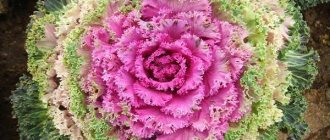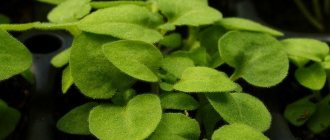Description of sweet pea
The height of sweet peas ranges from 1 to 2 m. This must be taken into account when selecting a suitable support. Dwarf varieties of chin do not need it. The taproot system is practically highly branched. It goes to a depth of 1.5 m. Distinctive features also include:
- pinnate leaves;
- antennae that provide traction with the support;
- inflorescences originating in the axils of leaf blades. The corollas from which the multi-flowered raceme is formed have an irregular shape. Flowers are often compared to moths and sailing boats;
- the fruit, which is the bean. Inside it are large spherical seeds. Their rough surface often has dents. Color varies from light yellow to black-brown. The seed remains viable for 8 years;
- weakly branched climbing stems.
China loves warmth and sunshine. The largest and brightest buds appear when this garden crop is grown in the Northern or Central zone. In the southern regions they are smaller and more inconspicuous.
Reproduction occurs through self-pollination. Abundant flowering begins in mid-summer. If the gardener follows all the tips, the peas will bloom until frost. This crop can tolerate temperatures down to -5 °C. To obtain seeds, it is enough to leave the required number of bivalve beans until they are completely ripe. The remaining inflorescences must be removed after wilting.
Types and varieties of sweet peas
Perennial peas produce purple or pink inflorescences. The palette of annuals that have been bred by breeders is much more extensive. Corollas can be blue, white, burgundy, blue, red and pink.
Therefore, gardeners most often plant hybrids obtained as a result of selection of the main varieties.
All types of sweet peas can be divided into several categories.
| Group | Description |
| Spencer | Tall, multi-stemmed. Produces strong flower stalks. The inflorescence is formed from 3-5 corollas. The petals have wavy edges. The color depends on the variety. Varieties: Aristocrat - whitish-pink flowers with a sweetish aroma; Sir Arthur - soft lilac; Sir Charles - scarlet. |
| Fantasy | Compact, no higher than 20 cm. Used as ground cover and planted in borders. |
| Cuthbertson | Long stems, multi-flowered racemes. Each has at least 8 corollas. Looks good when cut. |
| Mammut | Up to 30 cm. Powerful peduncles, on which many large bright corollas appear during the flowering period. |
| Royal | Early flowering and heat resistant. The flowers are durable and strong. These varieties are grown only in summer. |
| Bijou | The height of the bushes does not exceed 30 cm. During the flowering period, large bright corollas appear. |
| Pink Cupid | The flowers are distinguished by their original color. The length of the shoots is about 30 cm. |
| Winter Elegance | They reach 180 cm. Unlike other varieties, abundant flowering is possible not only in summer, but also in autumn. |

Variety of perennial sweet peas
About 1000 varieties of peas are known, all of them are divided into groups. The easiest way to classify plants is by stem length.
- Tall. This category includes varieties reaching 3 m in length. Strong flower stalks up to 35 cm high are intended for cutting; they are also suitable for landscaping.
- Medium height. Representatives of the group are more compact in size and do not require support. The stem length is 60-90 cm, the flowers are large, double, with a pleasant subtle aroma.
- Miniature. The group combines low plants with strong stems 15-45 cm long. Ideal for decorating flower beds and goes well with other summer plants.
In each category there are varieties that are worth paying special attention to. When choosing seeds, it is worth considering that many varieties of foreign selection have low germination and form buds later than their domestic counterparts. Let's talk about the most popular groups and name interesting varieties.
- White pearl is a broad-leaved chin, a perennial plant, blooms from June to November, reaches a height of 2 m, the flowers are very large, pure white, collected in 10 pieces in loose racemes. Plant only in a sunny place, then there are many shoots and all are very tall. Mainly used for vertical gardening. Bouquets of cut inflorescences are good.
- Pink pearls differ from White pearls only in the color of the inflorescences. The flowers are also very large, bright pink, of extraordinary beauty. For the winter, in early November, the root system is hilled up to a height of 15 - 20 cm, the above-ground part is cut off or removed from the support and laid as a shelter, and cut off in the spring. In the second year, the plants quickly reach a height of 2 m.
- Pearl mixture (Holland) - flower colors are pink, white, red. Overwinters with slight hilling of the root system. Seeds are sown in open ground in June, after soaking them in water for a day. For better tillering, seedlings are pinched above the 3rd - 4th leaf. Blooms in July, August, September.
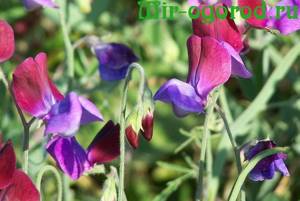
Growing sweet peas from seeds
Sweet peas are planted with seeds in two ways: seedlings (in the Northern and Middle latitudes) and without seedlings (perennial in the South).
Seedling method of growing sweet peas
To achieve a decorative effect, it is necessary
- soak the seed in the spring;
- create greenhouse conditions for seedlings. With a lack of heat, moisture and sunny color, the sprouts will be less viable;
- take into account the color of the seed shell when carrying out preliminary preparation.
The first step is seed treatment. To determine which of the collected or purchased fruits will sprout, you need to immerse them in a saline solution. To prepare it you will need 30 g of salt and one liter of water. Those that have settled to the bottom are used for sowing. Selected seeds are washed and filled with plain water (+50 °C) or with 1-2 grams of Bud product. The beans are kept in it for 12 hours. This softens the dense shell. Soaking is a mandatory step for fruits colored brown and brown. When planting light and cream beans, you will have to discard it.
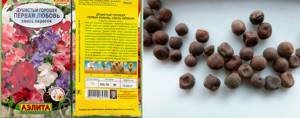
The next stage is germination. To do this, carefully wrap the seeds in a damp cloth and place the resulting package in a warm place. Seedlings emerge 2 weeks after planting. To speed up this process, experienced gardeners pierce the shell of each seed with a needle.
After the peas hatch, they are placed in prepared glasses. They should be covered with transparent film. Through it, a suitable temperature regime is created. To prevent the seedlings from stretching, you need to pinch them.
You can buy the soil mixture for filling the containers or make it yourself. It usually includes turf soil, peat and humus. It must be disinfected before planting. Sweet pea seeds are buried 30 mm in glasses. The distance between them is left at least 80 mm.

To avoid problems with transplanting seedlings, it is recommended to plant fragrant china in peat or plastic cups. The soil in the container must be moistened regularly. In poor lighting, it is necessary to install phytolamps near the glasses. To speed up the growth of side shoots, pinching is carried out. Another mandatory step is feeding the seedlings. Plants are shed with Kemira solution.
A non-seedling method for growing sweet peas
To sow sweet pea seeds directly into the ground, the soil must be prepared in advance. The selected area must be dug, loosened and leveled.
In spring, you can sow seeds in the ground in late April-early May. But flowering will occur much later than the seedling method.
There are several benefits to planting in the fall. Among them are faster adaptation of seedlings to climatic conditions and abundant flowering throughout the summer. The procedure is quite simple. Seeds are sown after frost occurs. The seed material is laid out in furrows. The depth of each of them should not exceed 5 cm. 3-5 cm are left between the seeds. This distance will be sufficient for normal plant growth. Afterwards, the bed needs to be covered with a layer of dry soil and compacted. Due to their cold resistance (down to -5 °C), peas will overwinter in the soil without losing their varietal characteristics (only for the Southern regions). If all recommendations are followed, seedlings will appear by mid-May.
When sowing in spring, the seeds should be buried 2-3 cm.
Planting sweet peas in the ground
Seedlings must be hardened off before planting. They do this for 1.5 weeks. The time spent in the fresh air increases each time. Gradually the plant will get used to temperature changes, which will have a positive effect on its viability.
Grown seedlings are transferred to the ground in mid-May. The procedure should be carried out in cool weather. Ignoring this recommendation may result in burns on the delicate leaves.
The planting location is chosen based on protection from drafts and lighting. The best way out of the situation may be the sunny side of the gazebo. In this case, you should leave room for support.
At the preparatory stage, mineral fertilizers must be added to the soil. Sweet peas grow best in moisture-permeable and loose soil. Optimal acidity is from 7.0 to 7.5 pH.
Holes are made in the dug area. The distance between them should be at least 0.25 m. 2-3 seedlings should be planted in one hole.
When planting, the gardener needs to follow a few simple recommendations:
- Sweet peas should not be planted in the same area for several years in a row.
- To ensure proper growth, after the first pair of true leaf blades have formed, the plant should be attached to a support or trellis.
- China grows best on the sunny side.
- Fertilizers need to be applied twice a month.
- The stems should be placed on a vertical surface. Otherwise, it is fraught with the occurrence of rot and disease.
Pre-sowing activities
Sweet pea seeds and the soil in which the seedlings will live begin to be prepared in late March. To obtain seedlings, seed material is soaked in a light solution of potassium permanganate (0.1%) for 30–40 minutes. Then the seeds are washed, dried and placed in well-warm water up to 50 ° C. To achieve maximum vegetation, it is recommended to keep water with seedlings in a thermos or under a steam hood for 24 hours.
After a day, the seeds must be transferred to a prepared gauze pad and kept there for 3 to 5 days, after which they are sent to prepared peat soil.
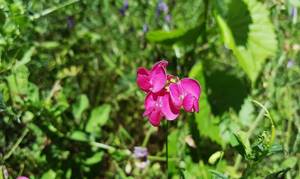
Preparing the soil mixture
To prepare a suitable soil composition, you need to take 2 parts of peat, one each of turf and garden soil, as well as half a glass of washed river sand. As a nutrient load, add a glass of wood ash to the resulting soil mixture for every 6 liters of soil. Peat cups are filled with the finished material to 2/3 of their actual volume.
Caring for sweet peas in the garden
To grow a fragrant tree, it does not require much effort and time. If all agrotechnical measures are carried out in a timely manner, difficulties will not arise. The regularity of watering is determined based on weather conditions. Watering should be plentiful, but infrequent. In the middle zone per 1 m²
it takes 3-4 buckets of water.
As they grow, the gardener will have to guide the stems in the correct direction along the support. In addition to pinching, fertilizing and watering, the list of necessary activities includes loosening and hilling. In this way, more luxuriant flowering of sweet peas is achieved.
When hilling, nutrient soil is added to the base of the plants. The composition of fertilizers depends on the growing season. The bushes are fed with a solution that contains Nitrophoska and urea.
Seedling care
A week or two after planting, shoots should appear, after which the shelter is immediately removed and the seedlings are transferred to a bright place with a temperature of about +16 degrees. A glazed loggia or greenhouse is best suited for this. If this is not possible, then the seedlings are placed on the southern windowsill.
Attention! With a lack of light, the plants will begin to stretch, so if the seedlings are on an eastern or northern windowsill, they need additional lighting (2-3 hours every morning or evening).
You will be interested to know: Autumn Helenium: planting and care in open ground, photo
Caring for seedlings while growing sweet peas at home includes:
- Regular watering. It is necessary to ensure that the soil does not dry out and at the same time is not too wet all the time. For irrigation use settled water.
- Pinching. When the seedlings have 2-3 true leaves, they are pinched. This is necessary in order to stimulate the formation of side shoots.
- Feeding. After pinching, the seedlings are fed with mineral complex fertilizer. You can use Kemira by first dissolving 2 grams of powder in one liter of water.
Before planting in open ground, sweet peas must be hardened off so that the plants adapt as best and quickly as possible to new growing conditions.
Preventive measures against pests and diseases
To prevent the appearance of aphids and weevils, the holes prepared for seedlings are treated with Chlorophos solution. In addition to it, you can use drugs such as Zineb and Ciram. There should be at least 15-20 days between preventive treatments.
Particular importance should be given to measures by which ascochyta blight, viral mosaic, peronospora and fusarium are resisted. To get rid of the first pathology, sweet peas are sprayed with a solution that contains Rogor.
When signs of downy mildew appear, the leaves must be covered with a solution of colloidal sulfur.
The occurrence of fusarium is indicated by the rapid wilting of foliage. Affected bushes will have to be removed and the ground disinfected. Otherwise, other plants will suffer.
The same will happen if sweet peas become infected with one of the viral diseases. It is impossible to cure these diseases.
Mr. Summer Resident Recommends: The Benefits of Growing Sweet Peas
China will decorate any garden plot. The popularity of this plant is due to its decorative properties and pleasant aroma. Due to the wide range of colors, a gardener will be able to choose the right variety without much difficulty.
The advantages of sweet pea include its versatility and unpretentiousness. Thanks to the dense foliage, a comfortable shade is formed. A bright carpet of multi-colored corollas will add uniqueness and charm to the garden. Additional bonuses include accelerated plant growth and a longer flowering period.

Tall peas are often planted for cutting. It is also valued in landscape design. It is used to create a background and decorate decorative elements. The latter play a role in this.
Ground cover varieties look good in alpine slides, borders, and flower beds located on hills. Thanks to its resistance to sudden temperature changes, sweet peas will delight the eye until late autumn.








